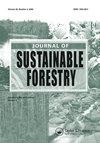Impact of Useful Species Preferences on Carbon Stocks and Annual Increments in Various Cocoa-based Agroforestry Systems in Central Region of Cameroon
IF 1.8
4区 农林科学
Q3 FORESTRY
引用次数: 0
Abstract
ABSTRACT This paper evaluates the potential effects of farmers’ species preferences on carbon stock in cocoa-based agroforestry systems (CAFS) in the Central Region of Cameroon. To achieve this goal, the species composition and structural variables of two land-use systems were investigated using 26 plots of 30 m × 30 m each, of which 20 were distributed in CAFS and 6 in adjacent secondary forests. Allometric models were used to estimate the species aboveground and root carbon stock. Ordination analysis indicated three types of species management systems: high-density timber and fruit trees; high-density Musaceae, palms and other shading trees; and low-density timber and fruit trees. The average densities of cocoa shading trees and shrubs were 234 ± 136 and 843 ± 360 individuals’ ha−1, respectively. Thus, the average potential carbon stock of the sampled CAFS was estimated at 186.97 ± 86.06 Mg C ha−1, 22% representing the root carbon stock. The transformation of secondary forest into various species management systems decreased the aboveground carbon by 18–34%. The annual rate of carbon accumulation estimated based on ring analyses was within the range 2.32–13.74 Mg C ha−1 year−1. The monetary value of the total carbon stored and the carbon accumulation rate were US$4042 ha−1and US$159 ha−1year−1, respectively.喀麦隆中部地区各种可可农林系统中有用物种偏好对碳储量和年增长的影响
摘要本文评估了喀麦隆中部地区农民的物种偏好对可可农林业系统(CAFS)碳储量的潜在影响。为了实现这一目标,使用26块30 m×30 m的地块对两个土地利用系统的物种组成和结构变量进行了调查,其中20块分布在CAFS,6块分布在邻近的次生林。异速生长模型用于估算物种地上和根系的碳储量。排序分析指出了三种类型的物种管理系统:高密度木材和果树;高密度的Musaceae、棕榈树和其他遮荫树;以及低密度木材和果树。可可遮荫树和灌木的平均密度分别为234±136和843±360公顷-1。因此,采样的CAFS的平均潜在碳储量估计为186.97±86.06 Mg C ha−1,22%代表根碳储量。次生林向各种物种管理系统的转变使地上碳减少了18-34%。根据环分析估计的年碳积累率在2.32–13.74 Mg C ha−1 year−1范围内。总碳储存的货币价值和碳积累率分别为4042公顷-1和159公顷-1年-1。
本文章由计算机程序翻译,如有差异,请以英文原文为准。
求助全文
约1分钟内获得全文
求助全文
来源期刊

Journal of Sustainable Forestry
Social Sciences-Geography, Planning and Development
CiteScore
3.90
自引率
12.50%
发文量
42
期刊介绍:
Journal of Sustainable Forestry publishes peer-reviewed, original research on forest science. While the emphasis is on sustainable use of forest products and services, the journal covers a wide range of topics from the underlying biology and ecology of forests to the social, economic and policy aspects of forestry. Short communications and review papers that provide a clear theoretical, conceptual or methodological contribution to the existing literature are also included in the journal.
Common topics covered in the Journal of Sustainable Forestry include:
• Ecology, management, recreation, restoration and silvicultural systems of all forest types, including urban forests
• All aspects of forest biology, including ecophysiology, entomology, pathology, genetics, tree breeding, and biotechnology
• Wood properties, forest biomass, bioenergy, and carbon sequestration
• Simulation modeling, inventory, quantitative methods, and remote sensing
• Environmental pollution, fire and climate change impacts, and adaptation and mitigation in forests
• Forest engineering, economics, human dimensions, natural resource policy, and planning
Journal of Sustainable Forestry provides an international forum for dialogue between research scientists, forest managers, economists and policy and decision makers who share the common vision of the sustainable use of natural resources.
 求助内容:
求助内容: 应助结果提醒方式:
应助结果提醒方式:


